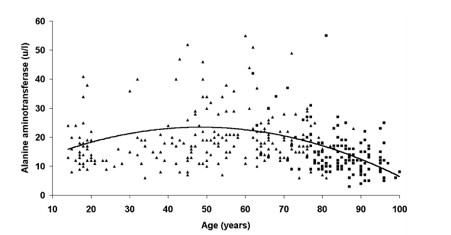ALT Level and age – How do they correlate?

ALT level has always been a reliable indicator of liver disease. Acting as a kind of enzyme that breaks down food into energy in liver cells, ALT is sent into the bloodstream when the liver is injured or inflamed, signalling problems within the liver. There is often a perception that only older adults would have elevated ALT level, but recent news suggest something different.
Young adults and their ALT levels
According to a survey conducted by SRL Diagnostics, a leading Diagnostics center and Pathology lab in India, there has been an increasing number of young adults below 40 having abnormalities in their liver enzymes, including ALT and AST (another hepatic enzyme).
The main causes can be attributed to their unhealthy lifestyle and eating patterns, for instance increased consumption of alcohol and high-fat junk food. As the National Center for Biotechnology Information in the US pointed out in a study, ALT and AST levels increased significantly when one takes more than 2 drinks per day. As young adults tend to live a sedentary lifestyle with an unbalanced diet and an overconsumption of alcohol, they are more prone to having abnormalities in their liver.
In another study that was published in The Journal of Pediatrics, there are more and more children at their mid-childhood who also have elevated ALT levels, which is primarily due to obesity.
What causes ALT level to rise?
As seen from the above study results, ALT level does not appear to correlate with age, rather it correlates more with one’s lifestyle and hepatic condition.
Causes like alcohol abuse triggers more release of ALT and AST into the bloodstream. Also, increased consumption of high-fat food often leads to obesity, which in turn contributes to a rise in ALT level and an increased chance of getting non-alcoholic liver disease. Other liver-related causes which lead to a rise in ALT level include cirrhosis and acute viral hepatitis.
However, does it always mean that the lower the ALT level the better, regardless of age?
ALT level and elderlies in general
According to a study that examines the correlation between ALT level and age, it was found out that ALT level dropped significantly with increasing age, regardless of one’s gender or hepatic condition. In another study, the same correlation was also presented, with a curve of the association of ALT with age shaped like an inverted-U, peaking before 50 years old.

It has been reported that ALT level decrease with age in both men and women. In fact, some evidence suggested that there is an inverse correlation between ALT level and mortality risk in elderly people. In a study that was performed on elderlies aged 70 or above, it was found out that subjects with below-average ALT level had reduced survival up to 4.9 years. Possible reasons such as decrease consumption of alcohol and decrease in the size of the aging liver contribute to the collective decrease of ALT level in the elderly population. Even though the elderlies have a different normal ALT level, liver diseases can still happen if they do not take care of the liver well. In fact, they should pay more attention to their liver health as chronic liver diseases are becoming more common among old patients.
While ALT level might not be an accurate biomarker of liver disease for the aged, it does not mean we should not pay attention to our ALT level. Since research has shown that liver disease is no longer restricted to age, it is of crucial importance to start protecting our liver as early as possible in order to avoid any form of liver disorders.
- Business Standard, http://www.business-standard.com/article/news-ians/young-adults-more-at-risk-of-liver-function-abnormalities-says-survey-april-19-is-world-liver-day-118041900977_1.html (Accessed: 2018-05-11)
- News18, https://www.news18.com/news/lifestyle/health-and-fitness-young-adults-more-at-risk-of-liver-function-abnormalities-survey-1723853.html (Accessed: 2018-05-11)
- Deccan Chronicle, https://www.deccanchronicle.com/lifestyle/health-and-wellbeing/200418/world-liver-day-lack-of-awareness-raises-burden-of-diseases.html (Accessed: 2018-05-13)
- National Center for Biotechnology Information, https://www.ncbi.nlm.nih.gov/pmc/articles/PMC3870491/ (Accessed: 2018-05-13)
- Oxford Academic, https://academic.oup.com/ije/article/40/6/1539/804384 (Accessed: 2018-05-13)
- Weizmann Institute of Science, https://www.weizmann.ac.il/immunology/elinav/sites/immunology.elinav/files/2005_elinav_am_j_gastro.pdf (Accessed: 2018-05-13)
- Clinical Gastroenterology and Hepatology, https://www.cghjournal.org/article/S1542-3565(11)01086-X/pdf (Accessed: 2018-05-13)
- Endocrinology Advisor, https://www.endocrinologyadvisor.com/obesity/childhood-obesity-risks-fatty-liver-disease/article/756848/ (Accessed: 2018-05-13)
- National Center for Biotechnology Information, https://www.ncbi.nlm.nih.gov/pubmed/19212309 (Accessed: 2018-05-15)
- * All research and clinical data should be used as reference purposes only, results may vary.






